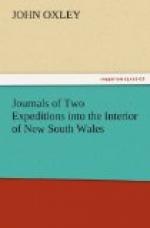The banks of the river were, I think, much lower, not exceeding fifteen or twenty feet high, and they were rather clearer of timber than before. The casuarina, which used to line the banks, was now seldom seen, the acacia pendula seeming to take its place. We stopped for the night on a plain of good land, flooded, but clear of timber: large flocks of emus were feeding on it, and we were fortunate enough to kill a very large one after a fine chase. At three o’clock, the boats not having arrived, I sent a man back to look for them; at eight he returned, having found them about six miles up the river, unable to proceed until morning, having met with continual interruptions from fallen trees. These impediments in the navigation of the river obstruct our progress very materially, and its windings continue so great and frequent, that the distance travelled by land is nearly trebled by water.
May 9.—The boats not having arrived at ten o’clock, Mr. Evans proceeded with the Bat horses another stage down the river. Mr. Cunningham and I waited to bring up the boats, which shortly afterwards came in sight. We proceeded to join the horses, which we did about five o’clock, the boats having gone in that time nearly thirty-six miles, although the distance from the last station did not exceed seven in a direct line.
The country we had passed through during this day’s route was extremely low, consisting of extensive plains divided by lines of small trees: the banks of the river, and the deep bights formed by the irregularity of its course, were covered with acacia bushes and dwarf trees. The river, at the spot where we stopped, wound along the edge of an extensive low plain, being at least six miles long and three or four broad; these I called Field’s Plains, after the judge of the supreme court of this territory; they are the same which we saw from the top of Mount Amyot. The soil of these plains is a light clayey loam, very wet in many places; they were fringed round with that beautiful tree, the acacia pendula, which here seems to perform the part of the willow in Europe; the cypresses were also more frequent, and the banks of the river much lower than even those we passed yesterday. I cannot help thinking that the whole of this extensive region has been at some time or other under water, and that the present river is the drain by which the waters have been conveyed to lower grounds. It is evident that even now the plains (on those parts clear of trees) are frequently under water, and that at very high floods the wooded lands are so too, for it is almost impossible to distinguish any difference in their elevation; but the wooded lands, from being actually higher, seem to have given time for the growth of the diminutive timber with which they are covered, whereas the lower plains are too frequently covered to give time for such growth.
May 10.—The horses having strayed in the night, and it being nearly noon before they were found, I determined to make this a halting day.




